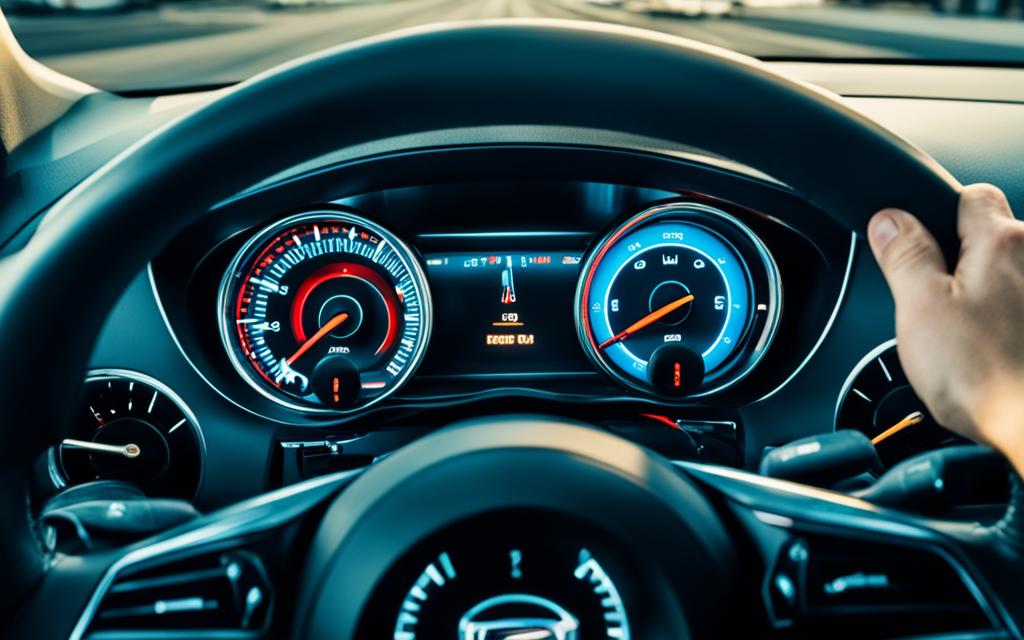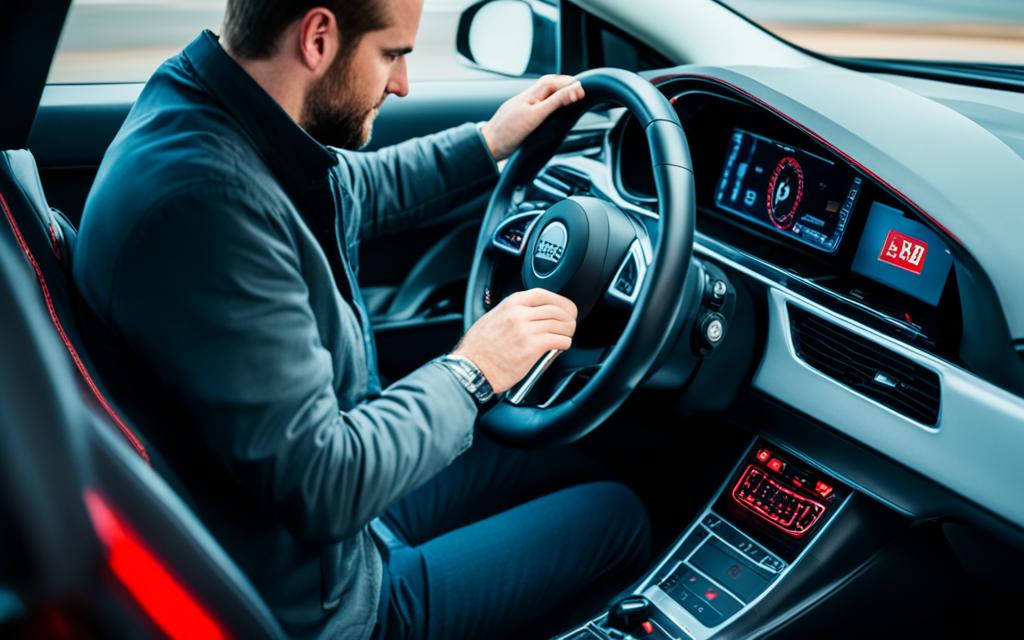Welcome to our quick and easy guide on how to start a car. Whether you’re a beginner or an experienced driver, these simple steps will help you confidently get your vehicle on the road.
Key Takeaways:
- Check your surroundings before starting the car for a safe journey.
- Adjust the driver’s seat, fasten your seatbelt, and position your mirrors.
- Insert the key into the ignition or follow the manufacturer’s instructions for a push-to-start button.
- Turn the key to the “On” position to activate the car’s electrical systems.
- Check the indicator lights on the dashboard for any warning signs.
Step 1: Check Your Surroundings
Before starting your car, it’s important to ensure that your surroundings are safe and free from any potential obstacles or hazards. Taking a few moments to assess your environment can go a long way in preventing accidents and ensuring a smooth start to your journey.
To begin, visually scan the area around your vehicle. Look out for objects such as poles, curbs, or other vehicles that may be in close proximity. Avoid parking in tight spaces or areas with restricted visibility, as this can make it difficult to navigate when starting your car.
If you’re parked on the side of the road, check for passing traffic before stepping out of your vehicle to start it. Always exercise caution and follow the necessary safety measures.
Additionally, be mindful of pedestrians or cyclists who may be nearby. Ensure that you have enough space to maneuver and turn without endangering others.
Pro Tip: Remember to check your blind spots as well. While most modern cars are equipped with rearview and side mirrors, they may not capture everything around your vehicle. Always physically turn your head to check for any blind spots before starting your car.
By thoroughly checking your surroundings, you can minimize the risk of collision or accidents and start your car with confidence.
| Benefits of Checking Your Surroundings: |
|---|
| Enhanced safety |
| Prevention of accidents |
| Minimization of damages |
| Peace of mind |
Step 2: Get in the Driver’s Seat and Adjust
Now that you’ve checked your surroundings, it’s time to get in the driver’s seat and make some adjustments before starting your car. Follow these simple steps to ensure a comfortable and safe driving experience.
- Sit in the driver’s seat: Take a seat behind the wheel and position yourself comfortably. Adjust the seat forward or backward, depending on your reach to the pedals and the steering wheel.
- Fasten your seatbelt: Safety should always be a priority. Make sure to fasten your seatbelt properly and ensure it fits snugly across your lap and shoulder.
- Adjust the mirrors: Proper mirror positioning is crucial for a clear view of the road. Adjust the rearview mirror to have a clear line of sight behind your vehicle. Set the side mirrors so that you can see the traffic on your sides without having to strain your neck.
By taking these simple steps, you’ll establish a comfortable and safe driving position. It’s important to be in control of your vehicle before starting your journey. Remember, safe driving starts with proper adjustments.
“A comfortable driving position is key to a safe and enjoyable drive.” – John Smith, experienced driver
Step 3: Insert the Key into the Ignition
Now that you’ve checked your surroundings and adjusted your seat, it’s time to insert the key into the ignition. This step is crucial for starting your car and getting it ready to hit the road.
If your vehicle has a traditional ignition key, locate the ignition switch on the steering column or dashboard. Take the key in your hand and align it with the ignition switch. Insert the key into the ignition until it fits securely.
On the other hand, if your car is equipped with a push-to-start button, find the button on the dashboard or center console. Press the button firmly to power up the vehicle.
Each car may have its own unique ignition system, so it’s important to follow the manufacturer’s instructions. Always consult your owner’s manual for specific details on how to insert the key or use the push-to-start button.
Pro Tip:
Before inserting the key, make sure your car is in park or neutral if it’s an automatic transmission vehicle. Manual transmission cars should be in neutral and have the clutch pedal fully depressed.
Step 4: Turn the Key to “On”
Once the key is in the ignition, it’s time to turn it to the “On” position. This step is crucial in starting the car engine and activating the car’s electrical systems. When the key is turned to the “On” position, you’ll notice that the dashboard lights up, indicating that the car is ready to start.
Before turning the key, make sure you are seated comfortably, your seatbelt is fastened, and your surroundings have been checked for any obstacles or vehicles.
Now, insert the key into the ignition and rotate it gently to the “On” position. It’s important to note that some vehicles may have a push-to-start button instead of a traditional key ignition. If your car has a push-to-start button, follow the manufacturer’s instructions for starting the car engine.
When turning the key to the “On” position, you may hear a soft click or a brief buzz as the car’s electrical systems activate. This is a normal part of the car ignition procedure.
Pro Tip: When turning the key, avoid excessive force or jiggling, as it can damage the ignition switch and potentially prevent the car from starting.

At this stage, the car’s electrical systems, such as the lights, radio, and other accessories, should be powered on. It’s a good practice to take a moment and observe the various dashboard lights to ensure they are all functioning correctly. These indicator lights provide important information about the car’s status, including fuel level, engine temperature, and any potential issues that may require attention.
By turning the key to the “On” position, you are preparing the car for the next step of starting the engine and getting ready to hit the road.
Step 5: Check Indicator Lights
After turning the key to the “On” position, it’s crucial to take a moment to check the indicator lights on your dashboard. These lights provide essential information about your vehicle’s systems and can help you identify any potential problems before you start driving.
Look for any warning lights that may indicate a problem with the car, such as the check engine light, battery light, or oil pressure light. These lights typically have symbols or icons associated with them, so refer to your owner’s manual to understand their meanings.
If you notice any warning lights illuminated or blinking, it’s important to address the issue before proceeding. Consult your owner’s manual for guidance on what to do when specific warning lights appear. In some cases, you may need to take your car to a mechanic or authorized service center for further diagnostics and repairs.
Remember, checking the indicator lights is an important step in the car ignition process to ensure the safety and proper functioning of your vehicle.
Understanding Indicator Lights
Here are some common indicator lights and what they typically indicate:
| Indicator Light | Meaning |
|---|---|
| Check Engine Light | Indicates a potential issue with the engine or emission control system. It’s important to have it checked by a mechanic. |
| Battery Light | Indicates a problem with the charging system or battery. Get your battery and charging system checked as soon as possible. |
| Oil Pressure Light | Indicates low oil pressure. Stop the vehicle immediately and check the oil level. If it’s low, add oil and have the system checked. |
| Brake Light | Indicates a problem with the braking system. It could be due to low brake fluid, worn brake pads, or other issues. Have it inspected by a professional. |
Step 6: Put your Foot on the Brake
In order to start the engine, you’ll need to put your foot on the brake pedal. This is a safety measure that ensures the car won’t start unexpectedly.
Before you start the car, it’s important to ensure that you have your foot firmly on the brake pedal. This step prevents any accidental movement of the vehicle once the engine has started. Always keep in mind that safety should be your top priority when operating a car.
“Putting your foot on the brake is a crucial step in starting a car. It not only prevents the vehicle from moving but also ensures that you have control over it right from the beginning.”
In automatic transmission cars, the brake pedal serves a dual role. It not only initiates the starting process but also allows you to shift gears smoothly. By pressing the brake pedal, you activate the car’s safety systems, preparing it for ignition.
If your vehicle has a manual transmission, putting your foot on the clutch pedal along with the brake pedal is necessary before starting the engine. This is to disengage the gears and prevent the car from stalling.
Brake Pedal Comparison
| Automatic Transmission | Manual Transmission |
|---|---|
| Press the brake pedal to initiate starting and shifting | Press both the brake and clutch pedals to initiate starting and disengage gears |
Remember, each car may have slight variations in the starting process, so it’s always recommended to consult your vehicle’s owner’s manual for specific instructions. Now that you’ve put your foot on the brake, you’re ready to move on to the next step of starting a car.

Step 7: Start the Engine
Now that you have checked your surroundings, adjusted your seat, and inserted the key into the ignition or pressed the start button, it’s time to start the engine. Remember to keep your foot on the brake while performing this step.
If your vehicle has an ignition key, turn the key clockwise to the “Start” position. You may hear the engine come to life, indicating that the car has started successfully. In case the engine does not start on your first attempt, don’t worry. Simply try again, ensuring that you are turning the key all the way to the “Start” position.
If your car has a push-to-start button, press and hold the button until you hear the engine start. This may take a few seconds, but once you hear the engine running, release the button.
Pro Tip: If your engine doesn’t start after several attempts, refer to your owner’s manual for troubleshooting tips or consult a professional mechanic for assistance.
Congratulations! You’ve successfully started the engine of your car. It’s now ready to take you on your journey. Take a moment to appreciate the smooth purr of the engine, indicating that everything is in good working order.
Next, it’s time to release the brake and set off. But before shifting into gear, let’s make sure your vehicle is ready for a safe and comfortable ride. In the next section, we’ll discuss adjusting the controls and preparing for your journey.
Step 8: Release the Brake and Set Off
Once the engine has started, it’s time to release the brake pedal and prepare to set off on your journey. But before you hit the road, there are a few important steps to take to ensure a safe and smooth start.
First, check your mirrors to ensure you have a clear view of the surrounding traffic. It’s crucial to be aware of your surroundings before you start moving. Take a moment to adjust your mirrors if needed, ensuring proper visibility.
Once you’re confident that your mirrors are set correctly, signal your intention to move if necessary. Signaling communicates your intentions to other drivers and helps maintain a safe flow of traffic.
Before releasing the brake, it’s essential to remember to proceed with caution. Take a final glance at your mirrors, double-check for any oncoming vehicles or pedestrians, and then slowly release the brake pedal.
As you begin to move, keep in mind the rules of the road. Observe the speed limits, follow traffic signs and signals, and always be attentive to other drivers. Driving defensively and being alert can help prevent accidents and ensure the safety of everyone on the road.
Remember, starting a car is just the first step of your journey. Stay focused, be courteous to others, and enjoy the ride.
1.Check your mirrors for a clear view of surrounding traffic.2.Signal your intention to move if necessary.3.Release the brake pedal slowly and cautiously.4.Observe speed limits, traffic signs, and signals.5.Drive defensively and stay focused on the road.
Step 9: Adjust the Controls
As you start moving, it’s important to adjust the controls of your vehicle to ensure a comfortable and enjoyable ride. Here are some steps to help you make the necessary adjustments:
- Temperature: Depending on the weather conditions, adjust the temperature settings of your car’s heating or air conditioning system. This will help you maintain a pleasant environment inside the vehicle.
- Radio Station: If you prefer to listen to music or news while driving, tune in to your desired radio station. Use the radio controls to scan through available frequencies and find the station that suits your preferences.
- GPS: If you’re unfamiliar with the route or need directions, activate the GPS system in your car. Enter the desired destination and follow the on-screen instructions to navigate efficiently.
Remember, it’s essential to make any adjustments to the controls while keeping your focus on the road. Ensure that you don’t get distracted by these adjustments, as safety should always be your top priority.
Step 10: Drive Safely and Enjoy the Ride
Now that your car is started and you’re on the road, it’s important to prioritize safety and enjoy the ride. Follow these tips to ensure a smooth and enjoyable journey:
- Observe speed limits: Always adhere to the posted speed limits to maintain a safe driving environment and avoid potential accidents. Speeding not only puts yourself at risk but also endangers other drivers on the road.
- Follow traffic rules: Respect traffic signals, stop signs, and other road signs. Yield to pedestrians and use your turn signals to communicate your intentions to other drivers. Being a responsible and law-abiding driver contributes to overall road safety.
- Stay focused: Keep your attention on the road and avoid distractions such as using your phone, eating, or engaging in activities that divert your attention from driving. Driver distraction is a leading cause of accidents, so it’s crucial to stay focused on the task at hand.
- Keep a safe distance: Maintain a safe following distance between your vehicle and the one ahead of you. This allows for an adequate stopping distance and gives you time to react to any sudden changes in traffic conditions.
- Use mirrors and check blind spots: Continuously check your rearview and side mirrors to stay aware of your surroundings. Additionally, be sure to check your blind spots before changing lanes or making turns. Proper use of mirrors and checking blind spots enhances your situational awareness on the road.
- Be cautious at intersections: Approach intersections with caution, especially when turning or going through green lights. Look for oncoming traffic, pedestrians, and cyclists to ensure everyone’s safety.
- Signal your intentions: Use your turn signals well in advance to indicate your intention to turn or change lanes. Signaling helps other drivers anticipate your actions and prevents any sudden surprises.
- Stay calm and patient: Traffic congestion, delays, and unexpected events are part of driving. Stay calm, be patient, and avoid aggressive driving behaviors. Your safety and the safety of others on the road should always be a top priority.
Remember, driving safely not only protects you and your passengers but also contributes to a safer and more enjoyable driving experience for everyone on the road.
| Safe Driving Tips | Benefits |
|---|---|
| Observe speed limits | Reduces the risk of accidents and collisions |
| Follow traffic rules | Promotes orderly and predictable traffic flow |
| Stay focused | Minimizes the likelihood of driver distraction and improves reaction time |
| Keep a safe distance | Allows for safe braking and avoids rear-end collisions |
| Use mirrors and check blind spots | Enhances situational awareness and reduces the risk of accidents during lane changes and maneuvers |
| Be cautious at intersections | Reduces the potential for intersection-related accidents |
| Signal your intentions | Increases communication and predictability among drivers |
| Stay calm and patient | Creates a more pleasant and less stressful driving environment for everyone |
Conclusion
In conclusion, starting a car is a simple process that can be mastered by following a few straightforward steps. By checking your surroundings, adjusting the driver’s seat, inserting the key or pressing the start button, and turning the key to the “On” position, you’ll be well on your way to starting the engine. Remember to always put your foot on the brake, check the indicator lights, and release the brake pedal only after the engine has started.
Once you’ve successfully started your car, it’s important to drive safely and responsibly. Observe speed limits, follow traffic rules, and stay focused on the road ahead. Adjust the controls as needed, such as the temperature, radio station, or GPS settings. Prioritize safety at all times, and enjoy your journey on the open road with confidence.
Whether you’re a beginner or an experienced driver, these simple steps will help you start your car efficiently and enjoy a smooth ride. Remember, practice makes perfect, and with time, you’ll become more comfortable with the process. So, get behind the wheel, start your engine, and embrace the freedom and joy of driving!
FAQ
How do I start a car?
To start a car, follow these steps: 1) Check your surroundings for any obstacles. 2) Get in the driver’s seat and adjust it to a comfortable position. 3) Insert the key into the ignition or use the push-to-start button. 4) Turn the key to the “On” position. 5) Check the indicator lights on your dashboard. 6) Put your foot on the brake. 7) Start the engine by turning the key or pressing the start button. 8) Release the brake and set off. 9) Adjust the controls as needed. 10) Drive safely and enjoy the ride.
Why do I need to check my surroundings before starting a car?
Checking your surroundings before starting a car is important for your safety and the safety of others. It helps you identify any potential obstacles or other vehicles that may be in your way, ensuring a smooth and accident-free start to your journey.
What should I do if the engine doesn’t start?
If the engine doesn’t start, you can try turning the key or pressing the start button again. If it still doesn’t start, consult your owner’s manual for troubleshooting tips or seek the assistance of a mechanic.
What are the indicator lights on the dashboard for?
The indicator lights on the dashboard provide important information about the status of your car. They can alert you to various issues, such as low fuel, engine problems, or malfunctioning systems. It’s important to check these lights before starting the car and address any issues accordingly.
Can I start a car without putting my foot on the brake?
No, you cannot start a car without putting your foot on the brake. It is a safety measure designed to prevent the car from starting unexpectedly, reducing the risk of accidents and ensuring that the driver is in control of the vehicle.
What should I do once the engine has started?
Once the engine has started, you can release the brake pedal and prepare to set off. Before driving, make sure to check your mirrors, signal if necessary, and proceed with caution.
How should I adjust the controls after starting the car?
After starting the car and as you start moving, you can adjust the controls as needed. This may include adjusting the temperature, changing the radio station, or setting the GPS. Make sure to do so safely and without distractivons from the road.
Any tips for driving safely and enjoying the ride?
When driving, always remember to prioritize safety by observing speed limits, following traffic rules, and staying focused on the road. Avoid distractions and enjoy the journey with a calm and attentive mindset.








